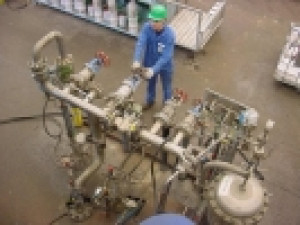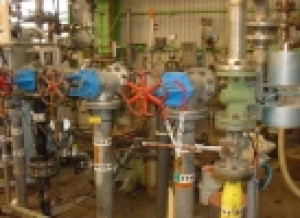A chemical platform emitted into the atmosphere 1,586 kg of monomer vinyl chloride (MVC) (i.e. a rate of 7.5 kg/sec of MVC). The accident occurred at 5:15 am while loading an autoclave with MVC, as the manual “drain first” valve had remained open. The technician was in fact interrupted during the preliminary degassing phase by an automated request on another autoclave. Upon his return, he forgot to close the degassing valve on the “drain first” circuit and authorised the filling step that caused a loss of MVC confinement via a 14-m high chimney. Once the error was recognised, the technician closed this valve and halted the loading sequence. The immediate site and all nearby points on the platform, including a workshop were evacuated. No adverse impacts on either the personnel or environment were recorded. The preliminary steps for introducing material into the reactor had been poorly designed and the “drain first” network monitoring protocol needed to be revised. Remedial measures were immediately undertaken; these included locking the upstream manual valve by a padlocked chain on the entire set of workshop autoclaves, thereby preventing any MVC filling of the reactor. To authorise the loading and allow opening of this valve, the same chain had to padlock the downstream manual valve in the closed position. This measure was adopted to draw the technician’s attention to the specific installation configuration. During the subsequent months, more concrete measures would be applied, namely: installation of a system preventing MVC filling whenever the so-called “intermediate” valve was in the open position; pressure measurement on the “drain first” line in order to confirm any presence of MVC along this network; and splitting the MVC loading task into 2 steps (at 200 kg initially, followed by a 2-min delay before resuming loading of the remaining 10 tonnes should no leak be detected). Loading was to be resumed upon automated authorisation with control room technician acknowledgment. During this time frame, a 7-member working group composed of plant personnel and members of the Corporate Hygiene and Safety Committee, headed by the workshop manager, was set up. The group’s assigned objective was to establish an action plan intended to list all manual operations capable of causing accidental situations and then implement barriers that serve to prevent human errors from occurring on those operations identified as sensitive (whereby the technician possessed 10 years of experience on this workstation and had been responsible for training newly-hired installation staff). This group met a total of 15 times and identified 39 sequences of manual operations potentially leading to a loss of MVC confinement. Suitable technical barriers were proposed, in some cases complemented by organizational barriers.
Download the detailed report in .pdf format (1.2 Mb)






